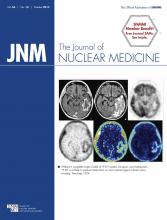In the 1970s, 18F-labeled sodium fluoride (18F-NaF), one of the most ubiquitous positron-emitting radiopharmaceuticals, was briefly used for skeletal scintigraphy before the introduction of 99mTc-labeled diphosphonates with optimal characteristics for conventional γ cameras (1,2). 18F-NaF is an analog of the hydroxyl group found in hydroxyapatite bone crystals and therefore an avid bone seeker (3). As with 99mTc-based bone-scanning radiopharmaceuticals that are bound to bone by chemical absorption, fluorine is directly incorporated into the bone matrix, converting hydroxyapatite to fluoroapatite (4). Because the protein-bound proportion is less for 18F-NaF than for 99mTc-medronate, 18F-NaF is more rapidly cleared from the plasma and excreted by the kidneys, with first-pass extraction approaching 100% (5). One hour after injection, only 10% of 18F-NaF remains in the plasma (1). Its desirable characteristics of high and rapid bone uptake accompanied by rapid blood clearance result in a high bone-to-background ratio in a short time. High-quality images of the skeleton can be obtained less than 1 h after the intravenous administration of 18F-NaF. Areas of high uptake on scans can result from any process that increases the exposed bone crystal surface or the blood flow.
See page 1507
The availability of PET/CT scanners in the United States and worldwide made 18F-NaF an attractive agent for bone imaging in the last decade. Investigators demonstrated its superiority over 99mTc-labeled diphosphonates for detection of bone metastases (6,7), an advantage that is in addition to the improved patient convenience due to the shorter duration of the examination. The Centers for Medicare and Medicaid Services issued a decision memorandum regarding the use of 18F-NaF PET (18F-fluoride PET) for detection of bony metastases in February 2010, concluding that the available evidence was sufficient to allow for 18F-fluoride PET coverage under the “coverage with evidence development” policy. This resulted in the creation of an 18F-fluoride PET branch of the National Oncologic PET Registry (8). By now, publications based on the data from this registry have validated the value of 18F-fluoride PET in multiple clinical scenarios such as initial staging, suspected first osseous metastasis, and suspected progression of osseous metastasis for prostate cancer and other cancers (9,10). In addition, evaluation of response to therapy in bone metastases is also possible using 18F-fluoride PET, as shown by early investigators such as Cook et al. (11) and by results from the registry in large cohorts (12).
In the current issue of The Journal of Nuclear Medicine, Rohren and colleagues present their experience with a method for determining the skeletal tumor burden in 98 consecutive patients who underwent 158 18F-fluoride PET scans for evaluation of skeletal metastatic disease (13). Using a threshold value for normal bone uptake, the authors were able to use whole-body segmentation to evaluate the skeletal tumor burden in a feasible and highly reproducible pattern. In addition, evaluation of response to therapy was also feasible for a subgroup of prostate cancer patients who received 223Ra treatment. These results build on published data that indicated differences in standardized uptake values between benign and malignant bone lesions, as well as between normal bone and lesions (14). The authors also showed in another recent publication that the determination of skeletal tumor burden may be able to predict overall survival in patients with prostate cancer treated with 223Ra (15).
Although novel PET tracers specific for prostate cancer have been shown to evaluate the extent of skeletal metastases accurately (16–20), 18F-NaF is widely available and has a relatively low cost. Therefore, it has the potential to remain the method of choice for the initial evaluation of extent of bone metastases. This requires robust methods for segmentation and quantification, just like what is proposed by Rohren et al. Their approach needs validation in larger studies before clinical adoption. Our group advocates the use of combined 18F-NaF and 18F-FDG in patients with selected cancers with a high propensity for bone metastasis (21). This combined technique also allows for semiquantitative measurements (22), and therefore segmentation methods for the evaluation of skeletal tumor burden should be feasible.
As more imaging centers begin using quantitative 18F-NaF routinely to interrogate for the presence of bone metastases, appropriate-use scenarios of skeletal tumor burden measurements will continue to emerge. These, together with the availability of functional and anatomic information provided by PET/CT and the recently introduced PET/MR imaging scanners, may yield new applications for the widespread use of 18F-NaF in clinical practice.
DISCLOSURE
No potential conflict of interest relevant to this article was reported.
Footnotes
Published online Aug. 20, 2015.
- © 2015 by the Society of Nuclear Medicine and Molecular Imaging, Inc.
REFERENCES
- Received for publication July 19, 2015.
- Accepted for publication July 21, 2015.







